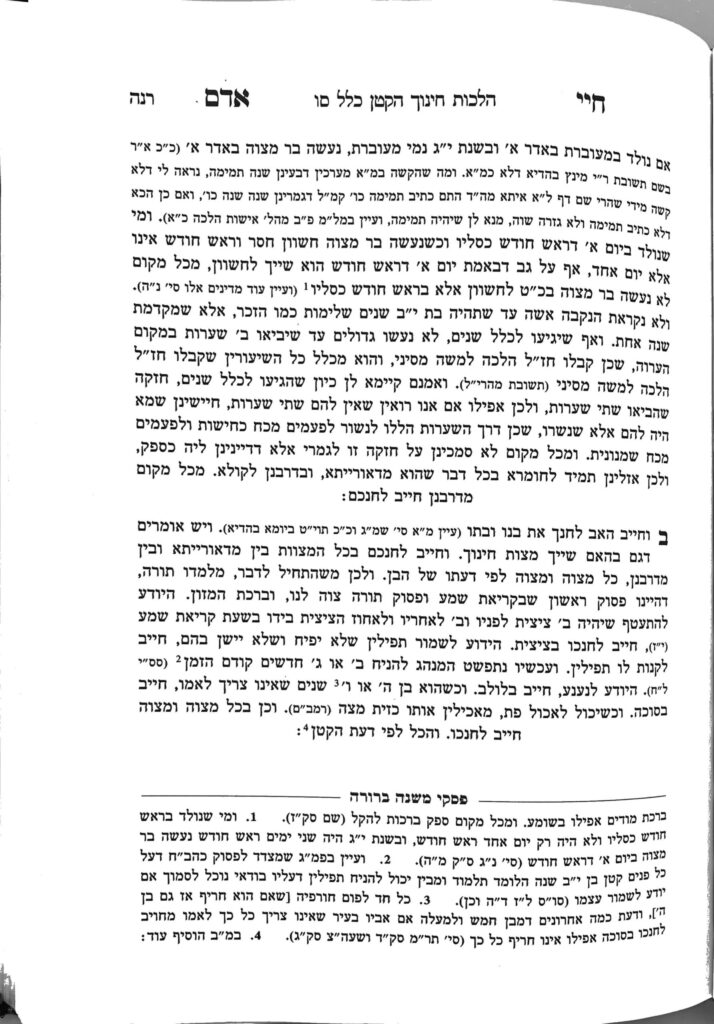We have finished siman 2, in which the Chayei Adam listed some examples of the proper age to begin chinuch in specific mitzvos. We have discussed the examples of lulav, talmud torah, birchas hamazon, brachos in general and kiddush. Today, we will discuss shema and tefillah.
The Chayei Adam mentioned that when a child begins speaking, a parent should teach them the first pasuk of kiryas shema. Teaching the first pasuk of shema is not in the context of the mitzvah of shema, but in the context of talmud torah.
There is a machlokes Rashi and Rabbeinu Tam whether there is a chiyuv chinuch for shema. Both agree that if here is a chiyuv chinuch, it is on the father, and once there is a chiyuv on the father, there is some level of chiyuv on the son as well. Rashi understands that since a child is often sleeping during the zmanei chiyuv, Chazal never instituted a chiyuv chinuch on the mitzvah of shema. Rabbeinu Tam disagrees, and holds that once the child has reached a chiyuv chinuch (which we have learned from the Mishnah Berurah is around six or seven), there is a chiyuv on the father to be mechaneich the child in shema.
The Shulchan Aruch writes that it is raui, proper, to be mechanech a child in shema, meaning that the primary psak is like Rashi, but it is proper to try to follow Rabbeinu Tam.
Again, this machlokes is independent of teaching the child the first pasuk of shema as part of talmud torah, but rather is the mitzvah of kiryas shema in conjunction with the mitzvah of kabbalas ol malchus shamayim.
The next step is chinuch in tefillah. As we have learned regarding kiddush, although there is an issur for an adult to eat before davening, chazal did not institute this issur for a katan.
Once a child has a chiyuv chinuch for tefilla, it would be proper to bring a boy to shul to be mechaneich them in tefillah betzibbur. However, the Mishnah Berurah points out that this chinuch only applies to a child who is able to respect the shul and the function of the shul. If the child will disrespect the shul and disrupt the tefillah, one has accomplished the opposite of chinuch. Thus, part of chinuch is to refrain from chinuch until the child is ready to receive the chinuch.
The poskim point out that the child must be clean before the child comes to shul, because if he is not, the father is machshil those davening around the child. Although this halacha is less applicable in our days, it is still noteworthy
There is a famous question about whether a child under the age of bar mitzvah can be included in a minyan. The Shulchan Aruch quotes an opinion which holds that one child may be counted for a minyan in a shaas hadechak, as long as the child knows to whom he is davening. However, we do not pasken in accordance with this view. Nevertheless, we do pasken that a child can receive maftir and lain the haftorah.
There is another question about whether a katan who is a kohen should perform birkas kohanim. On the one hand, the father has a chiyuv chinuch, but on the other hand, maybe it is not within the kavod of the tzibbur to receive a bracha from a katan. The halacha is that if there are other kohanim going up, the child may join them, but a child does not duchan by himself.
Even after the child has turned bar mitzvah, it is still not appropriate for the tzibbur to receive a bracha solely from a young adult on a regular basis. However, on an infrequent basis it is muttar.
If the entire minyan is young adults, such as a high school, it is muttar on a regular basis.
Once the child has reached the age that he is shaving, so he has the ability to produce a beard, he can duchan on a regular basis even in front of older adults.
Summary
- One has a chiyuv chinuch to teach their child the first pasuk of kriyas shema. This chiyuv is not connected to the mitzvah of shema, but rather to the mitzvah of talmud torah.
- There is a machlokes whether there is a chiyuv chinuch in the mitzvah of kriyas shema. The primary psak is that there is no chiyuv, but nevertheless, one should strive to fulfil the opinion that there is a chiyuv.
- There is a chiyuv chinuch in tefillah and tefillah betzibbur. However, before bringing a child to shul, a parent must ensure that the child is ready to respect the shul and act appropriately. Similarly, a parent must ensure their child is clean before bringing them to shul.
- A child under bar mitzvah cannot be counted for a minyan, but may receive maftir and lain the haftorah.
- A kohen under bar mitzvah may only duchan if there are other kohanim present. Even after bar mitzvah, a young adult should not duchan by himself for older adults on a regular basis until he is able to grow a bead. However, he may duchan for other young adults on a regular basis (e.g., a high school).



